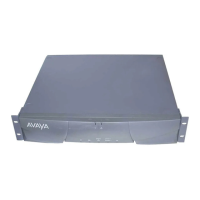Executing a Server Interchange
Issue 1 May 2002
4-15555-233-143
Executing a Server Interchange
Planned server interchanges are initiated on-demand by the reset system
interchange command, or automatically by scheduled daily maintenance. The
latter is administered with the System Parameters Maintenance screen. A
planned interchange normally has no perceivable effect on service. Every active
call, transient call, system link and stimulus, and data transmission is preserved.
The SYSAM-RMT port (also called the Remote Access Port) is dropped,
necessitating a re-login. The duration of the interchange is approximately one
minute.
Prerequisites
Several conditions must be met to guarantee a non-disruptive interchange. If
these are not met, the system will not execute the interchange. All of the following
conditions are expected to be met during normal operation:
■ The standby server must be fully in service.
That is, handshake is up, shadowing is on, memory is refreshed, and
standby server’s state of health (SOH) is “functional”. For more
information, see ‘‘Recovery’’ on page 3-5.
■ There can be no minor alarms against the standby’s PKT-INT MO.
■ There can be no ongoing disk operations on either active or standby MSS
components.
Wait until every such operation, such as a translation save or backup
restore, is complete before requesting an interchange.

